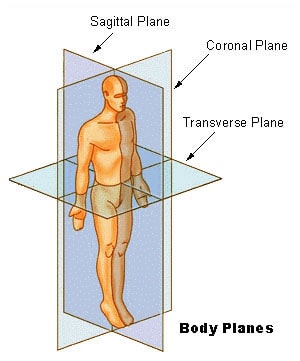In kinesiology, which is the study of human movement, there are three cardinal planes of movement: the sagittal, frontal, and transverse planes. All movements occur in these planes, or in some combination of these planes, which are then described as an oblique plane. When referring to the body, a plane is an imaginary flat surface that passes through the body. The three planes are described below.
 |
Sagittal: The vertical plane that passes through the body from front to back and is perpendicular to the floor. The movements that are associated with this plane are bending your trunk forward (flexion) and backward (extension).
Frontal (Coronal): The vertical plane that passes through the body from side to side and is perpendicular to the floor. When your trunk bends to the side you are moving in the frontal plane
Transverse: The horizontal plane that passes through our body and is parallel to the floor. When you rotate your trunk and head to look over your shoulder you are moving in the transverse plane.
Why does all of this matter and how do I apply it to my life?
Each of our joints was designed to move in a specific plane. By training the body to move in these specific planes correctly and with the proper stabilizing musculature, we can protect and preserve the integrity of our musculoskeletal system. It is when we start moving in the incorrect plane that our joints incur stress and break down over time. Here at APT we feel that the more you know about these concepts the better prepared you are to have a successful rehabilitation and stay healthy.
The following exercises will illustrate movement in the three planes. These are wonderful exercises to help your mind and body understand the planes of movement, and begin to restore the normal mobility of your joints.
 |
The seated thoracic and cervical extension exercise illustrates movements through the sagittal plane. The start position is seated as shown with your body lined up in neutral. This is a very subtle movement that sometimes requires practice to perform correctly.
Inhale: Prepare.
Exhale: Gently lift your breast bone towards the ceiling as you slide your shoulder blades back and down to open your chest. Bring your head backwards slowly, as if your eyes are following an imaginary line up the wall. Only go as far as feels natural, making sure to keep your head from falling backwards.
 |
The Mermaid illustrates frontal plane movement. The start position for this exercise is seated with your pelvis and spine in neutral either with legs crossed as pictured or seated in a chair.
Inhale: Reach one arm toward ceiling
Exhale: Starting at the base of your spine, side bend toward the opposite side. Visualize reaching over a big ball so your spine lengthens as you reach. Stay in the frontal plane – do not rotate or flex or extend your body.
Inhale: Return your trunk to vertical.
Exhale: Lower your arm to start position.
 |
The spinal rotation exercise occurs in the transverse plane. Again, the start position is seated with your legs crossed and body lined up in a neutral position. Your arms are parallel to the floor with your elbows bent to 90 degrees. The scapula are stabilized with your neck muscles relaxed.
Inhale: Prepare
Exhale: Starting at the base of your spine, rotate your entire spine to the right. Visualize spinning around a rotisserie, being careful not to bend forward, backward or to the side. Your head should also follow the movement
Repeat to the left.
| Works Cited |
Body Planes. Photograph. Athlepedia. 20 May 2008. Web. 24 Jan. 2012. <http://athletics.wikia.com/wiki/Planes_of_Motion>.
Brunnstrom, Signe, L. Don. Lehmkuhl, and Laura K. Smith. Brunnstrom’s Clinical Kinesiology. Fourth ed. Philadelphia: F.A. Davis, 1983. 2-6. Print.

Comments